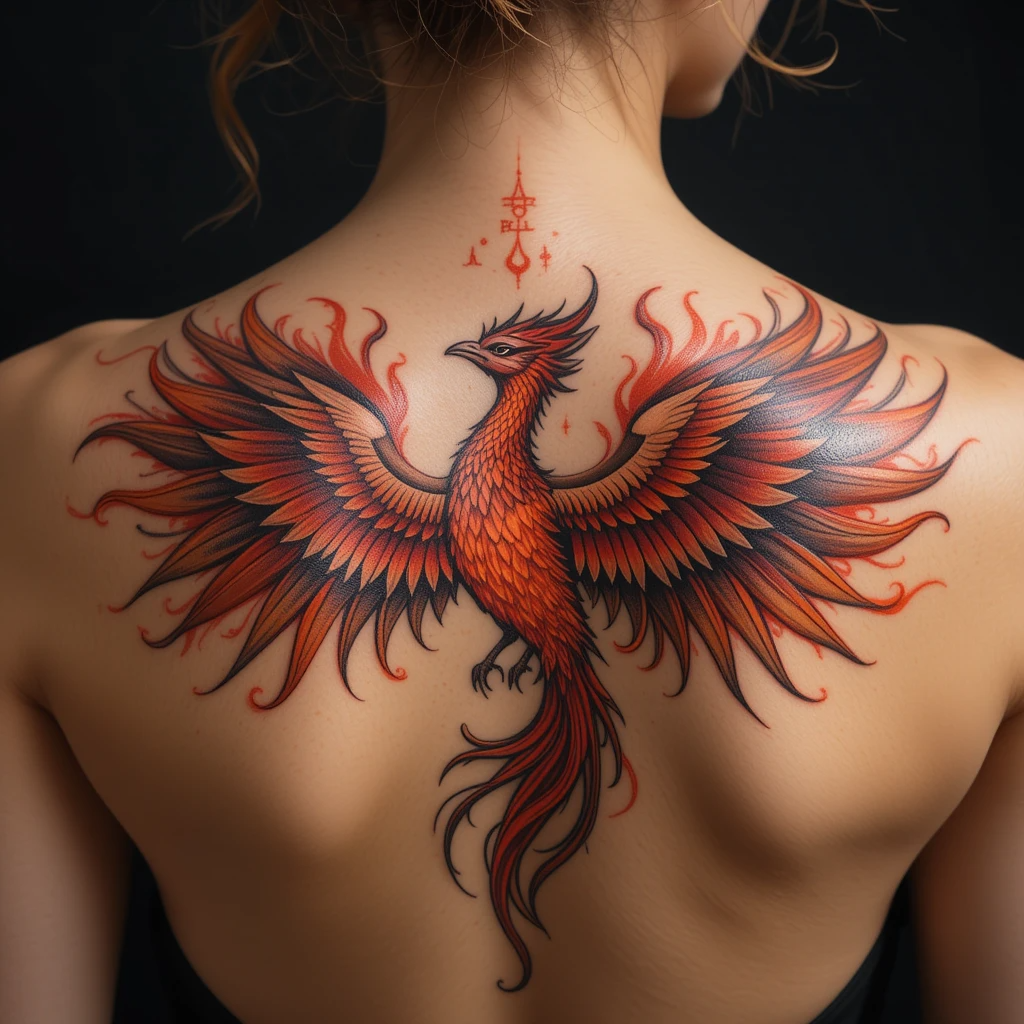In the realm of large-scale tattoo artistry, few subjects command the same reverence and artistic challenge as the phoenix. This mythical bird, with its powerful symbolism of rebirth, transformation, and eternal renewal, has become one of the most sought-after designs for expansive back pieces. The phoenix tattoo represents not merely decorative body art, but a profound statement of personal transformation and resilience that demands both artistic mastery and deep symbolic understanding.
The back, as the largest uninterrupted canvas on the human body, provides the perfect stage for phoenix imagery to unfold in all its dramatic glory. These tattoos transcend simple decoration to become wearable mythology, carrying centuries of cultural significance while showcasing contemporary tattoo artistry at its finest.
The Mythological Foundation
The phoenix holds deep significance across multiple cultures, each contributing layers of meaning to modern tattoo interpretations:
Greek and Roman Origins: In classical mythology, the phoenix lived for 500-1,000 years before building a nest of aromatic wood and spices, igniting itself, and rising renewed from its own ashes. This cycle of death and rebirth made the phoenix a symbol of resurrection and eternal life.
Chinese Tradition: The Fenghuang, often called the Chinese phoenix, represents virtue, grace, and the union of yin and yang. Unlike its Western counterpart, the Chinese phoenix symbolizes peace and prosperity, often depicted with elaborate plumage in vibrant colors.
Egyptian Connections: The Bennu bird, associated with the sun god Ra, shares phoenix characteristics and connects to themes of solar rebirth and the cyclical nature of time.
Persian Influence: The Simurgh of Persian mythology contributes healing and purification symbolism, adding layers of spiritual cleansing to phoenix imagery.
This rich mythological foundation provides tattoo artists and clients with extensive symbolic vocabulary, allowing phoenix tattoos to carry deeply personal meanings while honoring ancient traditions.
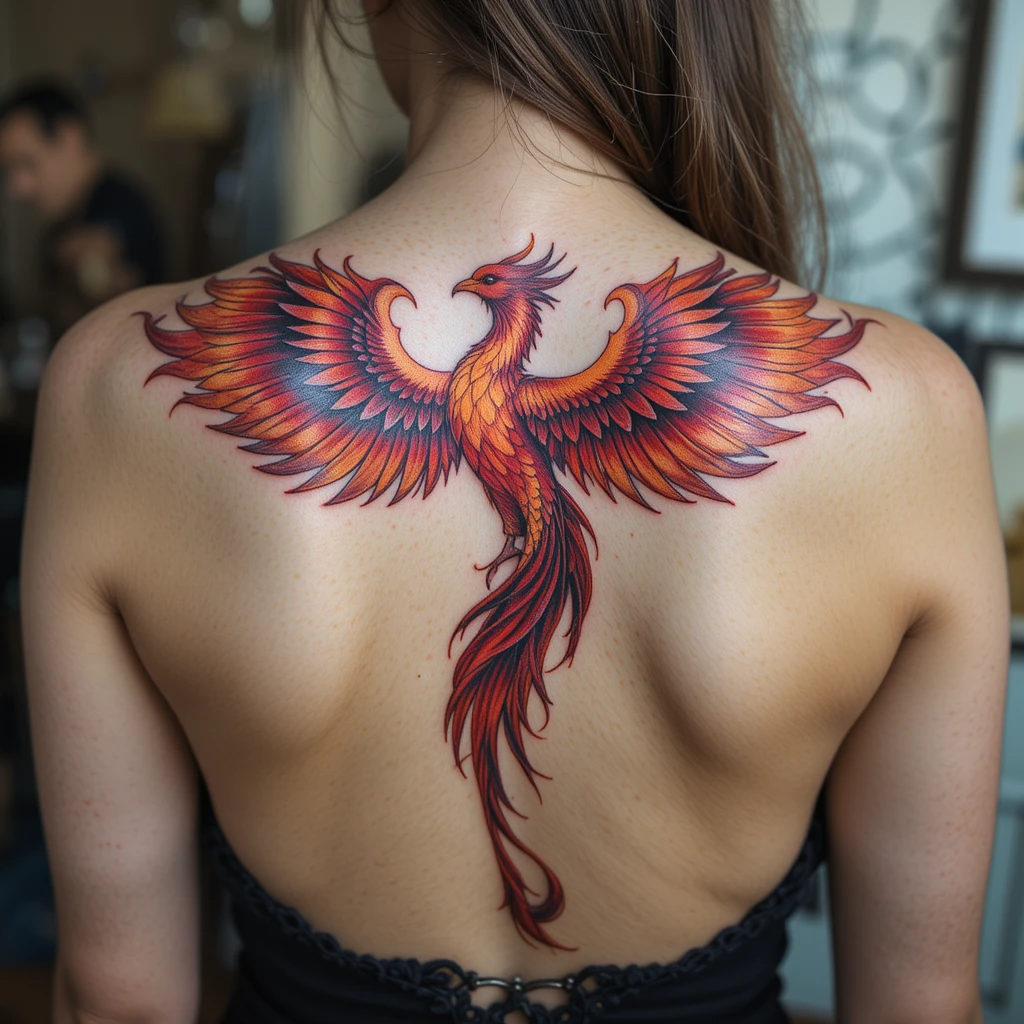
Anatomical Considerations for Back Phoenix Tattoos
The human back presents unique opportunities and challenges for phoenix tattoo design:
Natural Symmetry: The back’s bilateral symmetry allows for balanced wing placement that mirrors the body’s natural structure. This creates harmony between the tattoo and human anatomy.
Expansive Canvas: The broad, relatively flat surface of the back accommodates the phoenix’s need for dramatic wingspan and flowing tail feathers without significant distortion.
Muscle Movement: Understanding how back muscles flex and move ensures that phoenix designs maintain their integrity during normal body movement. Skilled artists plan for this dynamic relationship.
Spine Integration: The central spine provides a natural anchor point for the phoenix’s body, with wings extending across the shoulder blades and tail feathers flowing down the lower back.
Shoulder Blade Challenges: The prominent shoulder blades require careful planning to ensure wing designs work with, rather than against, these natural contours.
Design Evolution and Contemporary Interpretations
Modern phoenix tattoo artistry has evolved far beyond traditional representations:
Neo-Traditional Approaches: Contemporary artists blend classical phoenix imagery with modern tattoo techniques, incorporating bold colors, enhanced shading, and innovative composition approaches.
Realistic Interpretations: Some artists draw inspiration from actual bird anatomy, creating phoenixes that blend mythological elements with naturalistic bird features for enhanced realism.
Abstract Expressions: Modern phoenix tattoos may incorporate abstract elements, geometric patterns, or watercolor techniques that maintain symbolic meaning while pushing artistic boundaries.
Cultural Fusion: Artists increasingly blend different cultural phoenix traditions, creating designs that honor multiple mythological sources while creating something entirely new.
Minimalist Approaches: Even large back pieces can embrace minimalist principles, using clean lines and selective detail to create powerful phoenix imagery without overwhelming complexity.
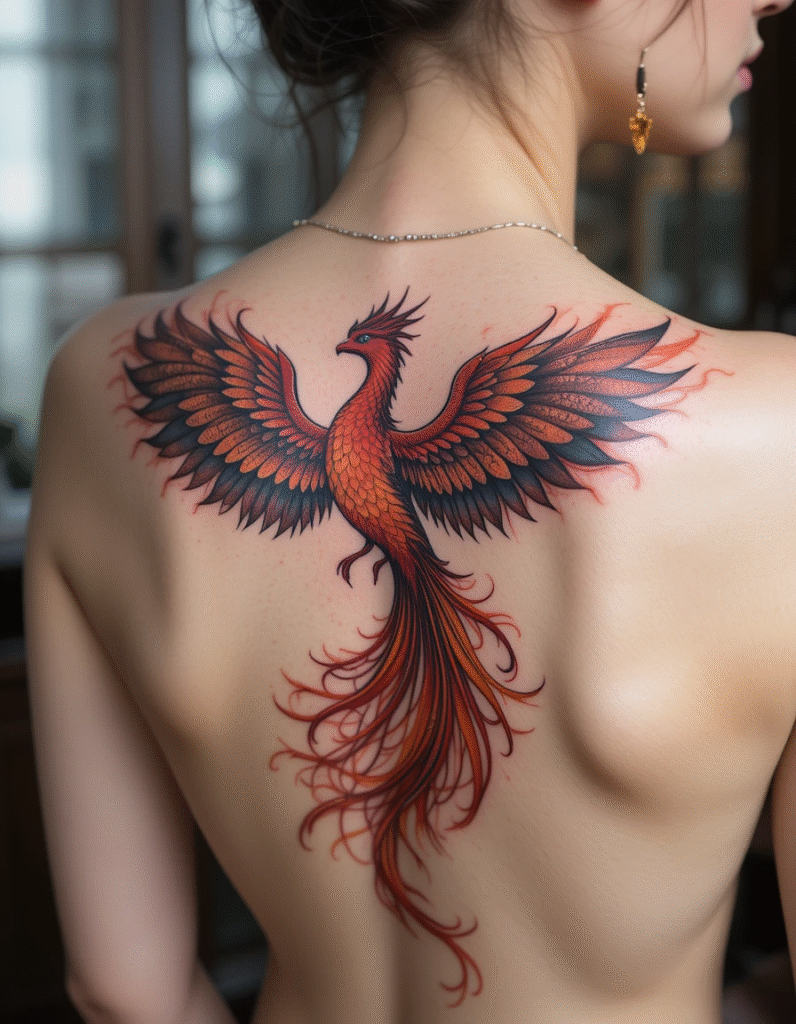
Color Psychology and Palette Selection
Color choices in phoenix tattoos carry significant symbolic weight and artistic impact:
Traditional Fire Colors: Reds, oranges, and yellows evoke the phoenix’s association with fire and rebirth. These warm colors create energy and movement while honoring traditional symbolism.
Royal Purples and Golds: These colors elevate the phoenix to regal status, emphasizing nobility and spiritual elevation. Gold accents can add luminosity and divine connection.
Sunset Gradients: Blending warm colors in gradient patterns creates natural fire effects while adding visual depth and movement to the design.
Monochromatic Approaches: Black and gray phoenix tattoos rely on shading, line work, and composition for impact, creating sophisticated, timeless pieces.
Jewel Tones: Deep emeralds, sapphires, and rubies can create rich, luxurious phoenix tattoos that emphasize the bird’s precious nature.
Metallic Accents: Incorporating metallic-toned inks can add luminosity and otherworldly quality to phoenix designs.
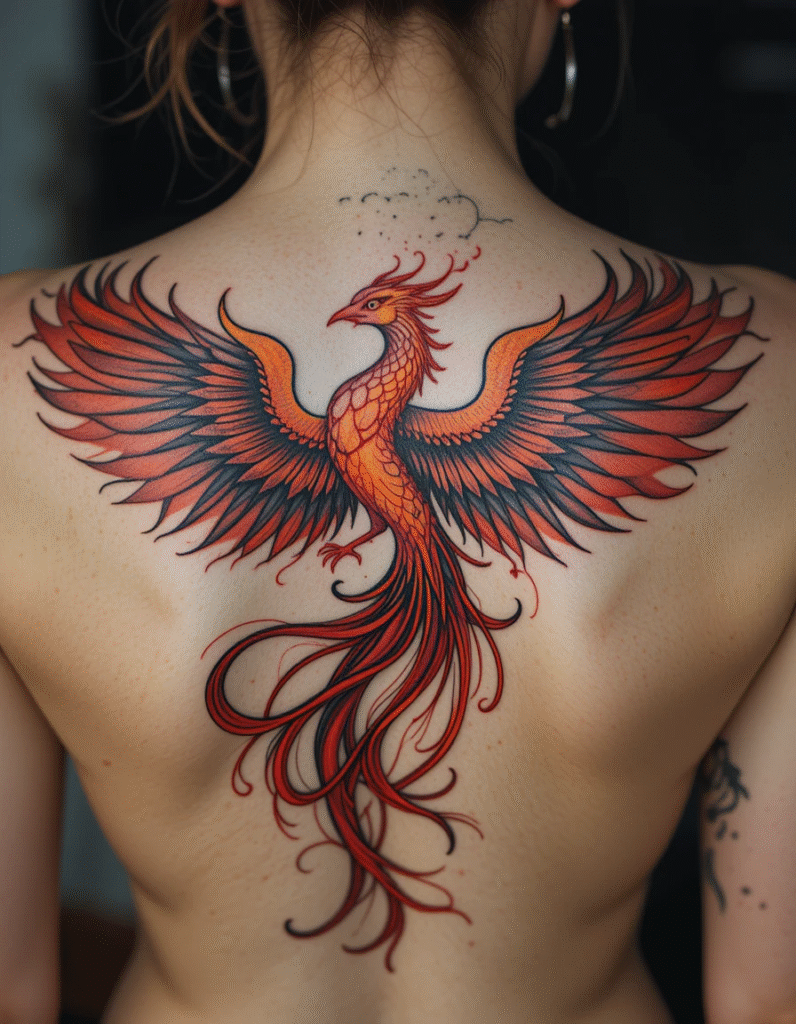
Technical Mastery Requirements
Creating exceptional phoenix back tattoos demands advanced technical skills:
Line Work Precision: Phoenix feathers require incredibly precise line work to maintain definition and flow. Each feather must be individually crafted while contributing to the overall composition.
Shading Expertise: Creating depth and dimension in phoenix wings requires masterful shading techniques that build volume and movement across large areas.
Color Blending: Smooth color transitions that mimic natural fire or bird plumage demand expert color theory knowledge and blending techniques.
Composition Balance: Balancing a phoenix across the entire back while maintaining visual weight distribution requires sophisticated compositional understanding.
Detail Management: Managing fine details across such large pieces requires stamina, consistency, and unwavering attention to craftsmanship.
Planning and Design Development
Successful phoenix back tattoos require extensive planning:
Initial Consultation: Understanding the client’s personal connection to phoenix symbolism helps guide design decisions and ensures meaningful results.
Body Mapping: Careful measurement and mapping of the client’s back ensures proper proportions and optimal use of available space.
Sketch Development: Multiple sketch iterations allow for refinement of composition, proportion, and detail before committing to permanent ink.
Size Scaling: Determining optimal size ensures the phoenix has sufficient space for detail while maintaining impact and readability.
Session Planning: Large phoenix tattoos typically require multiple sessions, demanding careful planning for progression and healing between appointments.
Symbolic Personalization
Phoenix tattoos offer rich opportunities for personal symbolization:
Life Transitions: Many clients choose phoenix tattoos to mark significant life changes, recovery from illness, or personal transformation periods.
Overcoming Adversity: The phoenix’s resurrection symbolism resonates powerfully with those who have overcome significant challenges or trauma.
Spiritual Growth: The rebirth aspect appeals to individuals experiencing spiritual awakening or religious transformation.
Creative Renewal: Artists and creative professionals often connect with the phoenix’s cycle of destruction and creation.
Relationship Symbolism: Phoenix tattoos can represent the end of one relationship phase and the beginning of another, whether romantic, familial, or professional.
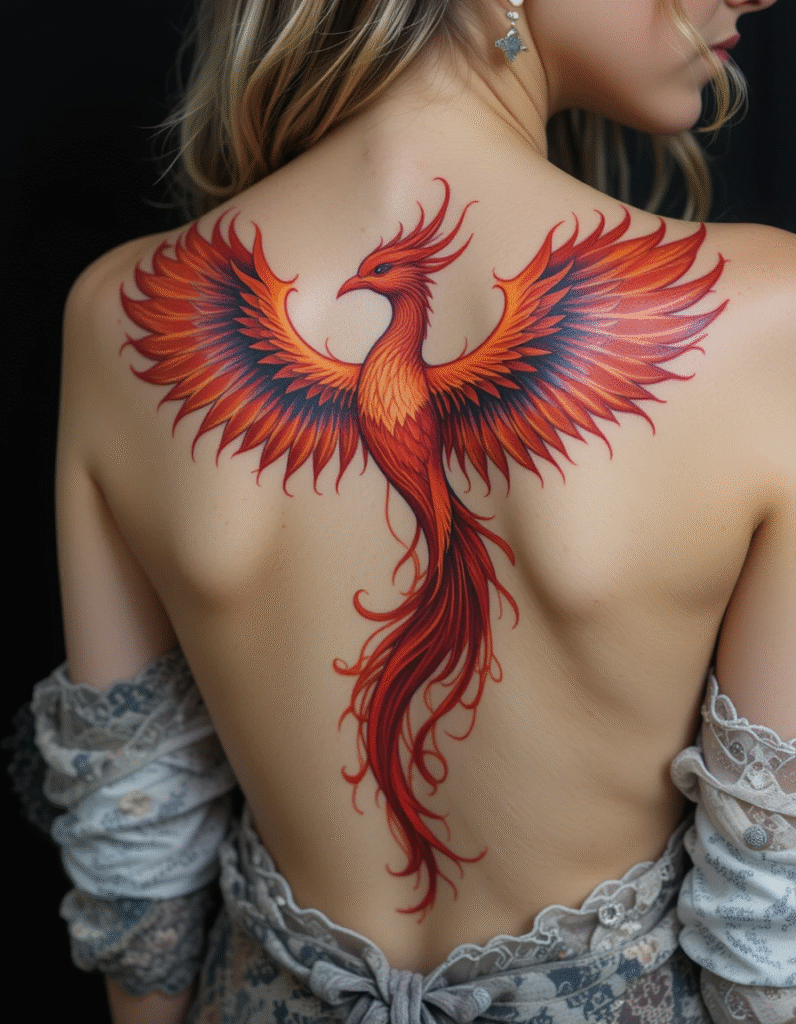
Cultural Sensitivity and Respect
Working with phoenix imagery requires cultural awareness:
Honoring Origins: Understanding and respecting the cultural origins of different phoenix traditions ensures appropriate representation.
Avoiding Appropriation: Careful consideration prevents cultural appropriation while allowing for respectful interpretation and personal connection.
Research Requirements: Both artists and clients should research the cultural significance of chosen phoenix styles to ensure respectful representation.
Contemporary Relevance: Modern interpretations should acknowledge traditional roots while allowing for contemporary personal meaning.
Pain Management and Endurance
Large back phoenix tattoos present unique pain management considerations:
Session Duration: Multiple long sessions require physical and mental endurance from both client and artist.
Pain Variation: Different areas of the back have varying sensitivity levels, requiring adjustment of technique and pacing.
Healing Coordination: Managing healing across large areas while maintaining design integrity requires careful aftercare planning.
Comfort Strategies: Positioning, breaks, and comfort measures become crucial for successful completion of large-scale work.
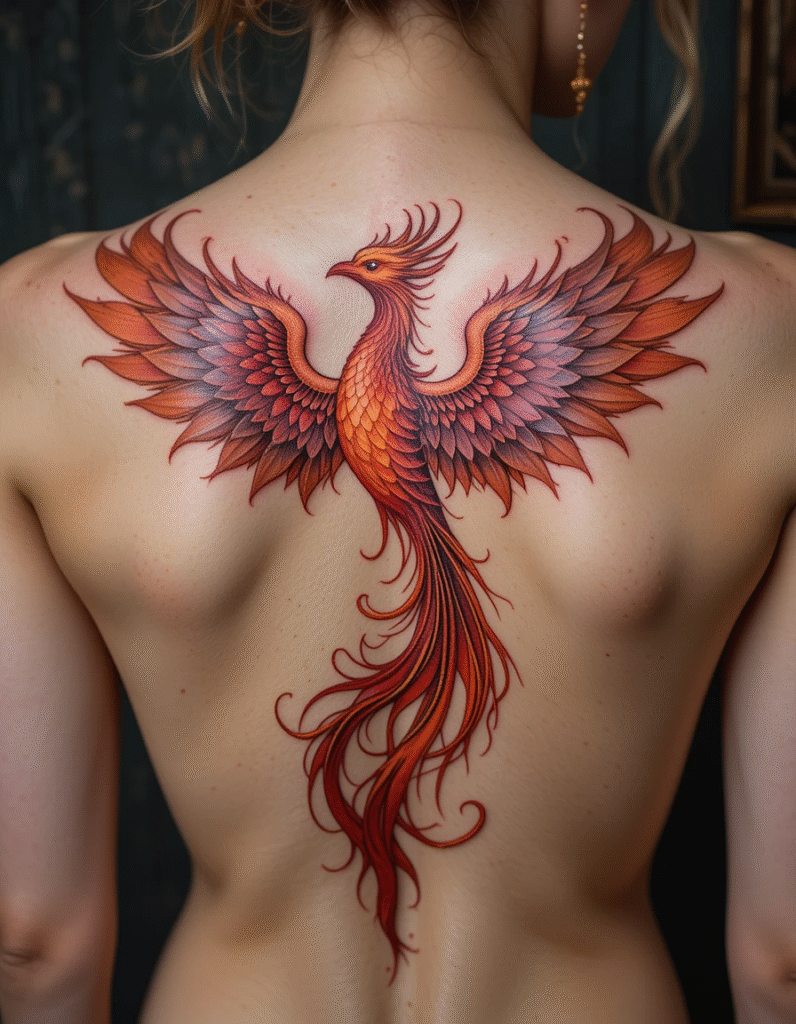
Aftercare for Large-Scale Work
Phoenix back tattoos require specialized aftercare:
Extended Healing: Large tattoos take longer to heal completely, requiring extended aftercare commitment.
Clothing Considerations: Back tattoos require careful attention to clothing choices during healing to prevent irritation.
Sleep Positioning: Healing large back pieces may require temporary sleep position adjustments.
Moisturizing Protocols: Maintaining proper moisture across large areas requires systematic application and quality products.
Photography and Documentation
Phoenix tattoos are particularly photogenic and require thoughtful documentation:
Lighting Considerations: Proper lighting showcases the colors and details of phoenix work while avoiding harsh shadows.
Positioning Techniques: Capturing the full scope of back phoenix tattoos requires strategic positioning and potentially multiple angles.
Detail Shots: Documenting both overall composition and intricate details preserves the full artistic achievement.
Progress Documentation: Recording the tattooing process provides valuable documentation of the artistic journey.
Investment Considerations
Phoenix back tattoos represent significant investments:
Financial Planning: Large-scale work requires substantial financial commitment, often spread across multiple sessions.
Time Investment: Completing a full back phoenix may take months or years, requiring long-term commitment.
Artist Selection: Finding artists capable of executing phoenix work at the highest level may require travel and premium pricing.
Maintenance Costs: Large tattoos may require periodic touch-ups to maintain optimal appearance over time.
Professional and Social Considerations
Large back tattoos carry social and professional implications:
Workplace Policies: Understanding professional environments and their tattoo policies helps guide design and placement decisions.
Concealment Options: Back placement allows for easier concealment when necessary, but large pieces may extend beyond easily covered areas.
Social Perception: Large, visible tattoos can influence social interactions and perceptions, requiring personal comfort with attention.
Long-term Commitment: The permanent nature of large tattoos requires confidence in long-term satisfaction with the design and placement.
Collaborative Artistry
Creating exceptional phoenix tattoos often involves collaboration:
Artist-Client Partnership: Successful phoenix tattoos emerge from genuine collaboration between artist vision and client meaning.
Multiple Artist Coordination: Some large pieces benefit from multiple artists contributing specialized skills.
Design Evolution: Allowing designs to evolve during the tattooing process can lead to enhanced final results.
Feedback Integration: Open communication throughout the process ensures alignment between expectation and execution.
Maintenance and Longevity
Preserving phoenix tattoos requires ongoing attention:
Sun Protection: Protecting colors from UV damage ensures long-term vibrancy and detail preservation.
Moisturizing Routines: Regular moisturizing maintains skin health and tattoo appearance.
Touch-up Planning: Anticipating and budgeting for periodic touch-ups maintains optimal appearance over decades.
Lifestyle Considerations: Understanding how lifestyle choices affect tattoo longevity helps preserve the investment.
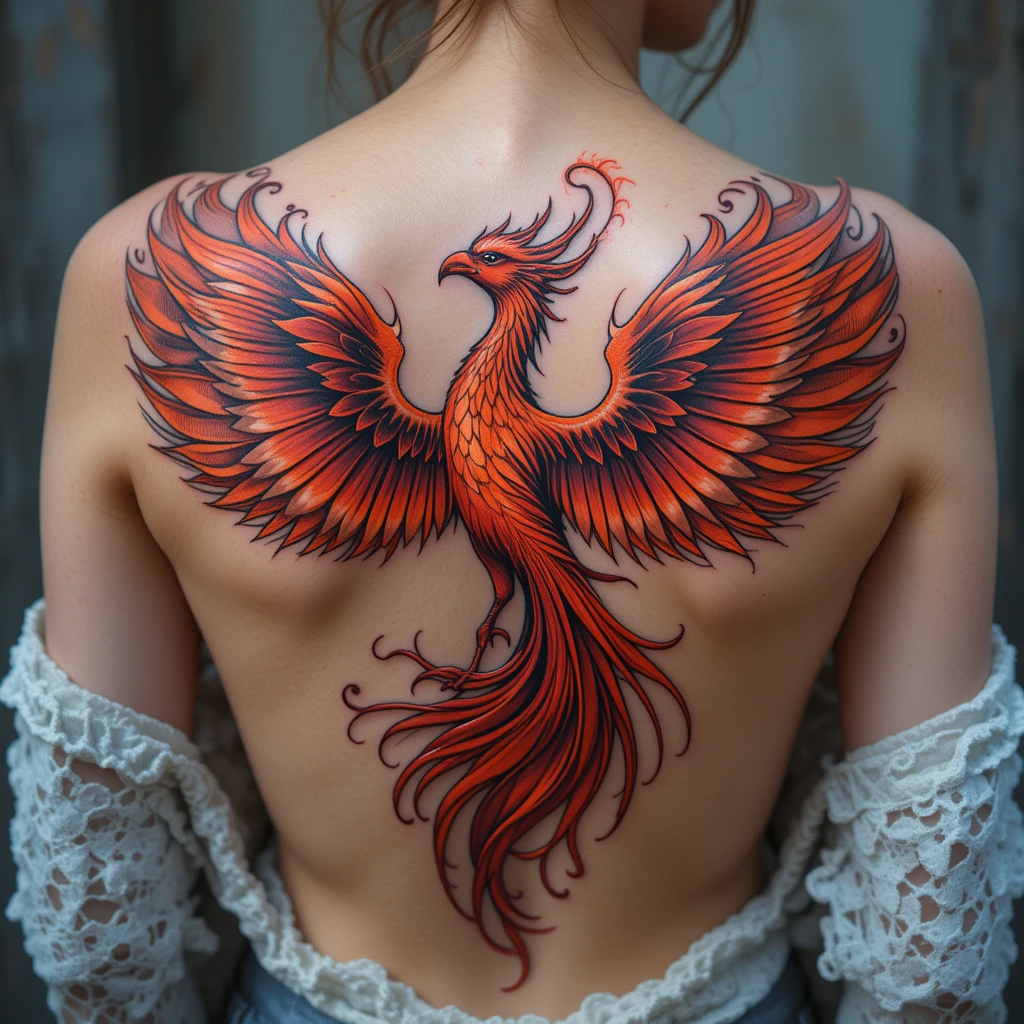
The Psychology of Transformation
Phoenix tattoos often represent profound psychological processes:
Identity Reformation: Many clients experience identity shifts during the tattooing process, with the phoenix serving as both symbol and catalyst.
Empowerment Through Art: The process of getting a large phoenix tattoo can itself be transformative, building confidence and self-expression.
Community Connection: Phoenix tattoos often connect individuals with communities of people who have undergone similar transformative experiences.
Ritual Significance: The tattooing process can serve as a modern ritual marking life transitions and personal growth.
Future Trends and Evolution
Phoenix tattoo artistry continues evolving:
Technology Integration: Advanced tattooing equipment and techniques enable increasingly sophisticated phoenix work.
Style Innovation: New artistic styles and approaches continue expanding phoenix tattoo possibilities.
Cultural Exchange: Globalization enables greater cross-cultural pollination of phoenix traditions and interpretations.
Healing Integration: Growing understanding of tattoos’ therapeutic potential may influence future phoenix tattoo approaches.
The phoenix tattoo, particularly as a large back piece, represents the pinnacle of tattoo artistry’s ability to combine technical mastery with profound symbolic meaning. These tattoos demand the highest levels of artistic skill, cultural understanding, and personal commitment, while offering unparalleled opportunities for transformation and self-expression.
As tattoo artistry continues evolving and gaining cultural acceptance, phoenix tattoos stand as testament to the medium’s capacity for creating meaningful, beautiful, and transformative art. They represent not just decoration, but wearable mythology that carries the power to inspire, heal, and transform both the wearer and those who witness these remarkable artistic achievements.
The phoenix, in its eternal cycle of death and rebirth, mirrors the transformative power of great tattoo artistry itself – the ability to take blank skin and create something that transcends the physical to touch the spiritual, the personal, and the universal. In skilled hands, phoenix tattoos become more than art; they become talismans of transformation, worn symbols of human resilience, and beautiful reminders that from destruction can emerge something more magnificent than what came before.

